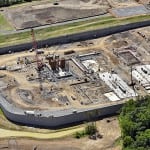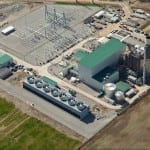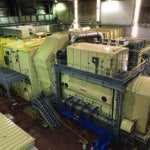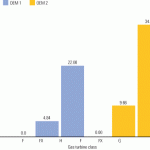Constructing a power plant is no small task. Due to the scope of the job, many projects experience schedule delays and cost overruns. However, with the right tools and teamwork, similar jobs can benefit through replication. Two projects—one in North Carolina and the other in Ohio—maximized engineering, procurement, and construction efforts with great success.
Two newly constructed 1x1x1 combined cycle power plants, developed by NTE Energy (NTE), located in Kings Mountain, North Carolina, and Middletown, Ohio, were engineered and constructed under the cohesive collaboration of NTE, original equipment manufacturers (OEMs), Gemma Power Systems, and Sargent & Lundy. Gemma Power Systems served as the engineering, procurement, and construction (EPC) contractor for the two sites, with Sargent & Lundy providing the full balance of plant (BOP) engineering and design.
Even though the projects were located at two different geographical locations with each having its own nuanced requirements, management and leadership focused on an optimized approach, wherein design, engineering, and procurement occurred on a singular basis in order to improve schedule and cost. In today’s EPC market, optimizing engineering schedule, reducing material quantities and equipment costs, while mitigating risk, align with the primary market drivers to improve EPC schedule and reduce cost.
Early equipment procurement and adoption of the singular design approach were strong contributors to the combined project’s successful execution. For most of the equipment, Gemma Power Systems issued a single purchase order for supply to both plants and consistently worked toward early procurement. This allowed for the system design to be performed once, with replication for the second site. Middletown Energy Center (MEC, Figure 1), the first plant in the sequence, started construction in August 2015, while Kings Mountain Energy Center (KMEC), started construction six months after in March 2016. KMEC realized significant benefits with engineering and construction both finishing ahead of schedule. MEC achieved commercial operation in May 2018, with KMEC’s commercial operation shortly thereafter in August 2018.
 |
|
1. The Middletown Energy Center in Middletown, Ohio. Courtesy: Gemma Power Systems |
The optimized approach to these projects has resulted in engineering efficiency gains that translated to shorter engineering schedule durations, design quantity reduction, and risk mitigation. Innovative 3D modeling technology—and the creative application of these tools—was a large component of this process. In the case of KMEC and MEC, the decision to use a single 3D intelligent model and plant design for both sites resulted in a nearly 2-for-1 engineering and design cycle. Although two major differences—site topography and enclosed versus exposed turbine halls—were present, neither were significant detractors to the successful implementation of this optimized approach.
Project Background
KMEC and MEC are natural gas-fired, multi-shaft, combined cycle power plants. Each power plant is arranged in a 1x1x1 configuration, capable of producing 475 MW nominally. The project team was comprised of the following:
- ■ Owner and developer—NTE
- ■ OEMs—Mitsubishi Hitachi Power Systems America (MHPSA, combustion turbine [CT]); Vogt Power (heat recovery steam generator [HRSG]); Toshiba (steam turbine [ST]); and TEI (condenser)
- ■ EPC contractor–Gemma Power Systems
- ■ Engineer—Sargent & Lundy
The major components of each plant consist of a MHPSA supplied M501GAC combustion turbine-generator, which exhausts into a steam tail comprised of a Vogt Power supplied HRSG, and a Toshiba supplied tandem-compound single-flow (TCSF) steam turbine-generator. The ST is capable of producing 225 MW with HRSG duct firing and 140 MW unfired. The low-pressure steam from the ST exhausts into a TEI supplied, water-cooled condenser.
Maximizing Replication
New power generation projects are expected to remain cost and schedule competitive. Teams—consisting of the owner, OEMs, engineering, and constructors—face the challenge of adding power to the grid with emphasis on value engineering to meet ever tightening budgets and schedules.
When constructing multiple projects at once, engineering may view each individual project as its own unique endeavor, neglecting to consider opportunities for streamlining efforts across the spectrum of projects. Handling each project uniquely can potentially drive up costs on the engineering, procurement, and construction sides due to performing the same tasks independently for each project. The project team recognized early how this approach could lead to added time and effort, as well as run up project costs, and took measures to maximize design redundancy by establishing templated specifications, bounding calculations, and more.
Headed by EPC contractor Gemma Power Systems, along with its lead design and engineering firm Sargent & Lundy, and OEMs MHPSA, Toshiba, and TEI, the MEC and KMEC projects took replication a step further. Major differences inherent to each project site posed challenges to the replication philosophy. Notably, the natural gas yards were different and MEC required a significant amount of its equipment to be enclosed within a building. Yet, the project team committed themselves to take advantage of every possible similarity between the two projects, creating the opportunity to construct two plants under one design.
Overcoming Challenges
The notable challenges the team faced from the onset of design, engineering, and constructing the KMEC and MEC projects under a singular design were that the two sites reside in different states that have differing climates and soil conditions, differing plant terminal point requirements, and MEC had to have much of its main OEM equipment installed within a building.
Despite being in different states, the engineering teams realized the climates of Kings Mountain, North Carolina, and Middletown, Ohio, were similar enough, which proved to be fundamentally key to the replication process. After performing the thermal calculations at the onset of the project, the differences in the heat and mass balances between the two sites were found to be minor. This resulted in the major OEM vendors specifying identical equipment between the two sites from a process standpoint.
Because the differences in process conditions between the two sites were minor, Gemma Power Systems and Sargent & Lundy developed procurement specifications that required most equipment vendors to design their equipment to meet the process conditions at both sites. Moreover, Gemma Power Systems and Sargent & Lundy consciously developed site criteria (such as snow loading, ambient design temperature, and seismic criteria) for the procurement specifications that represented the most-restrictive conditions at both sites to ensure identical equipment was delivered to the greatest extent possible.
Streamlining BOP equipment design and procurement under a singular design lowered the engineering and procurement costs for the overall project. In lieu of submitting two wholly different specifications for each site, a single specification was provided for a majority of the equipment, with any subtle differences concisely highlighted. Some equipment that would be indoors at MEC was installed outdoors at KMEC. Such outdoor equipment was specified to be rated for its conditions, equipped with NEMA 4X electrical boxes, and weather enclosures (air compressors). This not only ensured that the engineering and procurement effort was conducted once, it also allowed the team to deal with a single vendor between the two sites for particular pieces of equipment, at times, affording a better price for the equipment due to the doubled quantity being purchased. This also resulted in reduced man-hours for engineering and procurement.
Notwithstanding that KMEC is a fully outdoor power generating station, engineers and designers put forth effort to have general plan arrangements and structural designs be as similar as possible between the two sites. MEC required a slightly larger footprint due to needing a building to house its CT, ST, and condenser, while the overall plant layout for KMEC did not require a building. Simply put, the MEC footprint governed for both sites. Doing so allowed for the same mechanical, electrical, and structural steel to be designed, engineered, and procured for the two sites. Moreover, the overall structural foundation designs were similar, with only the piling design different due to the distinctive soil conditions present at each site.
Despite the differences present between the two plants, engineering and procurement cost savings were recognized due to the high degree of replication being employed between the two sites.
Scheduling and Management
At the onset of the project, NTE, MHPSA, Toshiba, Vogt Power, Gemma Power Systems, and Sargent & Lundy aligned to execute the design, engineering, and effort in procurement of the two power plants for a net reduction in total level of effort. With any new generation project, challenges arise during construction, such as equipment not being delivered as specified/approved or alignment of various construction trades to work in common areas. Staggering the construction schedule allowed a single site to experience and resolve these challenges, which benefited the second site.
An example was a critical system valve that was delivered with a different actuator than was originally modeled, resulting in interference with adjacent pipework. The MEC team was able to quickly assess the issue and employ a reroute of the pipework that was then shared with the KMEC team. The KMEC team, due to its schedule lagging MEC, did not require redundant engineering or experience any construction delays. Also, the staggered schedule gave KMEC the flexibility to start construction on some systems early due to the advanced engineering schedule. This allowed the construction team to reduce peak man-hours onsite and improve the overall construction schedule, coming online months early.
Team management and leadership monitored and enforced utilization of the full potential of the tools at their disposal to replicate the two sites. For example, Plant North was maintained to be the same for the two sites, allowing exploitation of layer commands within computer-aided design (CAD) programs for the development of BOP drawings such as piping and instrumentation diagrams, general arrangement drawings, schematic drawings, and physical drawings. Setting Plant North common for both sites allowed each respective 3D model to be nearly identical. Each site’s model was developed in a single common file because the orientation was the same. Any differences between the two sites were captured with the use of layer assignments for items that were site-specific (such as title blocks, indoor/outdoor scope breaks, etc.).
Management and leadership enforcement of a singular design also included drawing reviews, design review meetings, and overall diligence of all team members, operating as a system of checks and balances. All of these factors not only minimized engineering man-hours, but led to an expedited construction schedule, allowing the plants to come online and produce power for their customers sooner.
With the trend in the power industry to optimize schedule while reducing cost, execution of a successful project is only as good as the cohesiveness of the entire team, including the owner, OEM vendors, EPC contractor, and the engineer of record. The project team’s early decision to design, engineer, and procure using a singular approach for two sites resulted in overall project schedule performance and cost reduction. ■
—Ankur J. Patel is a senior mechanical engineer with Sargent & Lundy; Joseph F. Peters, PE is a project manager with Sargent & Lundy; Nassar G. Jabour, PE is project engineering manager with Gemma Power Systems; and Nick P. Circolone, PE is a project manager with Sargent & Lundy.










